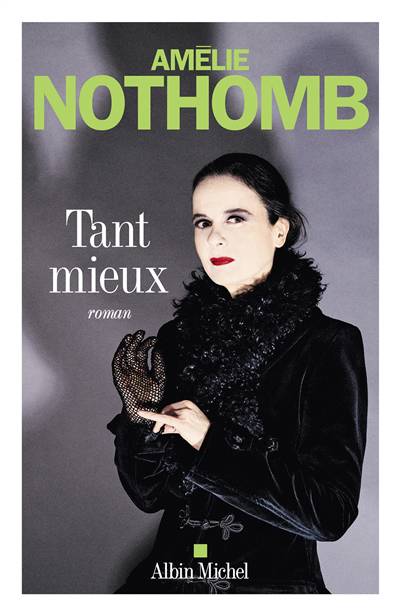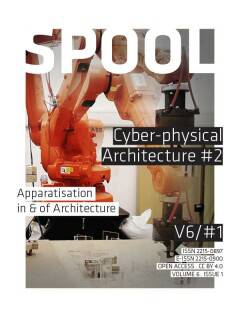
- Retrait gratuit dans votre magasin Club
- 7.000.000 titres dans notre catalogue
- Payer en toute sécurité
- Toujours un magasin près de chez vous
- Retrait gratuit dans votre magasin Club
- 7.000.0000 titres dans notre catalogue
- Payer en toute sécurité
- Toujours un magasin près de chez vous
Description
Apparatus and apparatisation, the focus of the Cyber-Physical Architecture (CpA) issue #2 of SPOOL, refer to an assemblage of various components, tools, and instruments that in combination produce an exponential surplus beyond the linear sum of parts.
The CpA #2 samples various interests afforded by the apparatus and apparatisation in and of architecture and how they open up new potentials and opportunities. The first article, Building as Apparatus? (by Leach) addresses the theme of “buildings-as-apparatus” through theoretical and historical discussions on politics, control, agency, and social impact by Foucault, Deleuze, and others. Leach argues that the architectural object in itself has no agency and the term “apparatus” should be understood as an embodiment of a larger system of culture, politics, and practices in which buildings can be a constituent part.
Architecture Machine Revisited (by van Ameijde) summarises a series of experiments organised at the Architectural Association between 2011 and 2017. The experiments investigate the intellectual notion of “the architecture machine” introduced by Nicholas Negroponte and the Architecture Machine Group (AMG) at MIT in 1967. The article focuses on technologies and work-flows that trace human activities and translate them into architectural structures as initiated by the AMG.
Discreet Robotic Assemblies (by Garcia, Retsin, and Soler) questions the acceptance of a continuous paradigm within robotic fabrication and proposes a model based on a discreteness, in which building elements are combined into larger assemblies, rather than being described by the rationalisation of a whole. Structural Adaptation (by Hidding et al.) explores the rationalisation aimed at improving structural performances and achieving multi-functionality, focusing on the design and robotic fabrication of a chaise longue that can change shape to function as both a bed and a chair depending on user requirements.
Finally, reflecting on today’s architectural theories and practices, Dialog #1 (by Bier and Green) discusses how high-technology as an intellectual model impacts architecture. They question the speed of implementation and the pervasiveness of high-technology in architecture in contrast to the continuation of the inherited practice.
The CpA #2 samples various interests afforded by the apparatus and apparatisation in and of architecture and how they open up new potentials and opportunities. The first article, Building as Apparatus? (by Leach) addresses the theme of “buildings-as-apparatus” through theoretical and historical discussions on politics, control, agency, and social impact by Foucault, Deleuze, and others. Leach argues that the architectural object in itself has no agency and the term “apparatus” should be understood as an embodiment of a larger system of culture, politics, and practices in which buildings can be a constituent part.
Architecture Machine Revisited (by van Ameijde) summarises a series of experiments organised at the Architectural Association between 2011 and 2017. The experiments investigate the intellectual notion of “the architecture machine” introduced by Nicholas Negroponte and the Architecture Machine Group (AMG) at MIT in 1967. The article focuses on technologies and work-flows that trace human activities and translate them into architectural structures as initiated by the AMG.
Discreet Robotic Assemblies (by Garcia, Retsin, and Soler) questions the acceptance of a continuous paradigm within robotic fabrication and proposes a model based on a discreteness, in which building elements are combined into larger assemblies, rather than being described by the rationalisation of a whole. Structural Adaptation (by Hidding et al.) explores the rationalisation aimed at improving structural performances and achieving multi-functionality, focusing on the design and robotic fabrication of a chaise longue that can change shape to function as both a bed and a chair depending on user requirements.
Finally, reflecting on today’s architectural theories and practices, Dialog #1 (by Bier and Green) discusses how high-technology as an intellectual model impacts architecture. They question the speed of implementation and the pervasiveness of high-technology in architecture in contrast to the continuation of the inherited practice.
Spécifications
Parties prenantes
- Editeur:
Contenu
- Nombre de pages :
- 54
- Langue:
- Anglais
- Collection :
- Tome:
- n° 6
Caractéristiques
- EAN:
- 9789463662000
- Date de parution :
- 19-07-19
- Format:
- Livre broché
- Dimensions :
- 212 mm x 280 mm
- Poids :
- 229 g

Les avis
Nous publions uniquement les avis qui respectent les conditions requises. Consultez nos conditions pour les avis.





